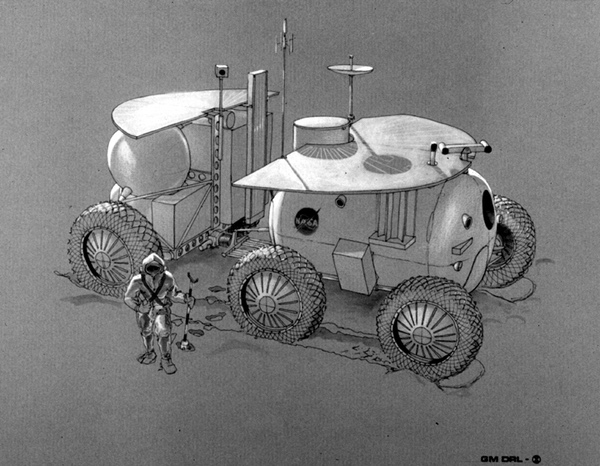Of Firebirds and lunar roversby Dwayne A. Day
|
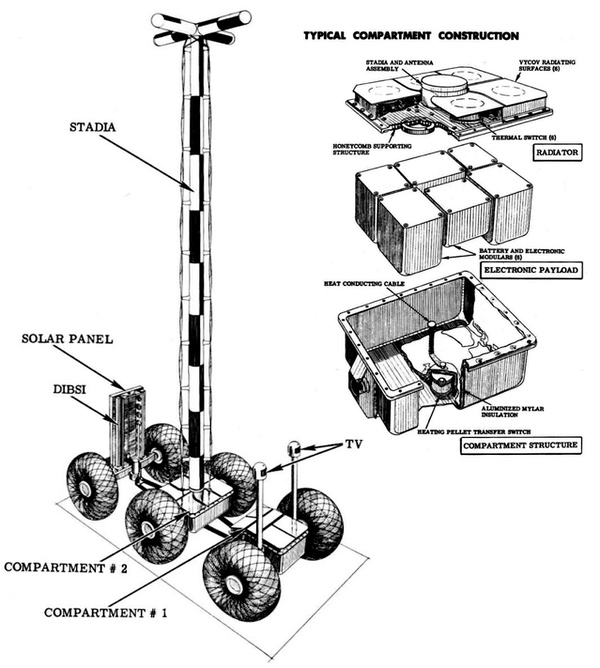 By the early 1960s, General Motors proposed a rover for the Surveyor lunar lander. The company built a prototype, which was tested by NASA but never pursued. The basic design of the drive assembly contributed to NASA's Mars rovers decades later. (credit: Norman J. James via GM Media Archive) |
The Surveyor rover
Norman J. James was an industrial designer and artist who went to work for General Motors in Detroit in the mid-1950s. There he helped design some of General Motors’ classic cars of the time such as the Pontiac Firebird. In 2007 he published Of Firebirds & Moonmen, A Designer’s Story From The Golden Age, about his years working for General Motors. James described his work on GM’s initial bid for the Surveyor lander, as well as a sample return version the company proposed after Hughes Aircraft won the Surveyor contract in early 1961. James worked on several other lunar projects for General Motors, which he also described in his book (see “Surveyor sample return: the mission that never was,” The Space Review, January 20, 2025.)
| They also sought to simplify the vehicle as much as possible based upon the engineering axiom that “the part that’s left off never breaks.” |
After working on the Surveyor Lunar Sample Return payload proposal in 1961, James went to work on a NASA request for proposals for large lunar-roving vehicles. He was soon producing multiple sketches of possible rover designs, everything from weird, tracked monstrosities to vehicles with ten wheels and multiple linked bodies. One concept included a vehicle with wheels over four meters in diameter.
By May 1963, James had transferred to a GM facility in Santa Barbara, the GM Defense Research Laboratories, which had previously been known as Defense Systems Division but had since been demoted to a laboratory. There he and others worked on the engineering design for the Surveyor Lunar Roving Vehicle proposal. GM’s proposed Surveyor rover was just under two meters long and had six wheels on three axles, “all connected by a flexible leaf spring/frame, which was also its suspension,” James wrote. “The end axles would articulate in unison to turn the vehicle.”
The last axle would carry solar panels and soil mechanics instruments, while the first two would carry the cameras and communications equipment. The rover would communicate through the Surveyor lander, which would have stronger transmitters for communicating with Earth.
The GM team built a prototype test vehicle and tested it in a “Lunarium” strewn with rocks and boulders and graded into small hills to simulate the lunar surface. A remote-controlled camera on top of a building simulated the Surveyor lander, and operators would track the vehicle’s progress using both its own camera and the one on the building.
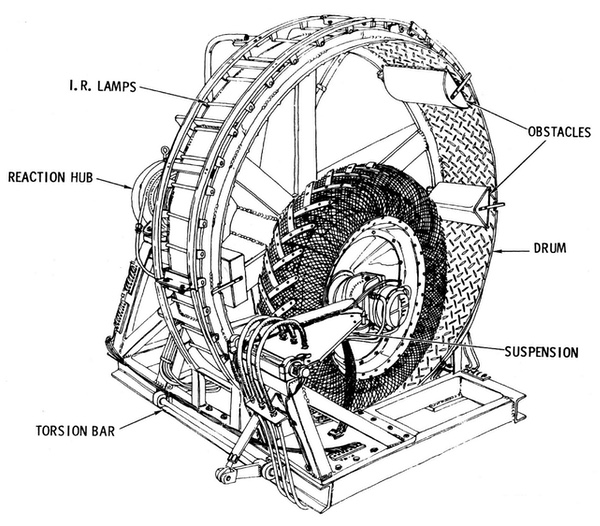 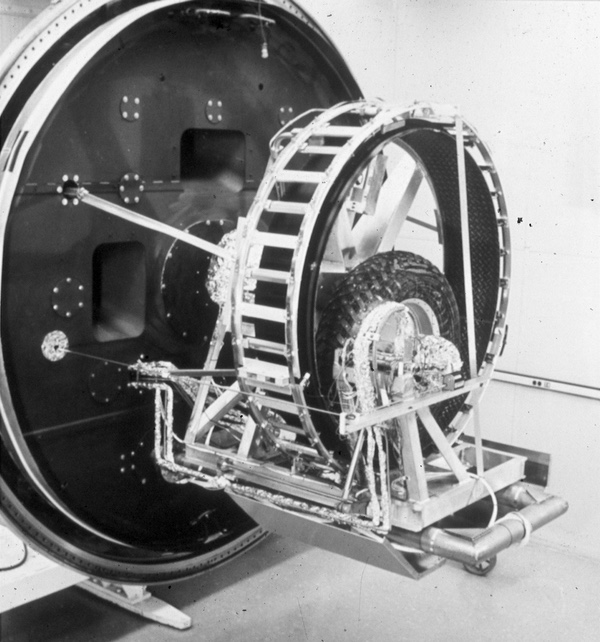 Much of GM's work on lunar rovers in the first half of the 1960s had focused on the wheels and drive mechanisms for propelling a vehicle around the surface. Later in the decade the company received a contract to develop a test rig for testing both General Motors and Bendix lunar wheel designs. This rig fit inside a thermal vacuum chamber and rolled the wheel over different obstacles. (credit: Norman J. James via GM Media Archive) |
According to James, this project forced the team of automotive designers into new areas of engineering that they were unfamiliar with, such as failure analysis and designing redundancy for the mission. They also sought to simplify the vehicle as much as possible based upon the engineering axiom that “the part that’s left off never breaks.”
| The GM team gradually came to realize that they were looking too far into the future—after the initial Apollo missions—when they should instead focus more on supporting Apollo. |
A major engineering challenge was that the temperature on the lunar surface could vary dramatically from extreme heat to extreme cold. “Conventional rubber tires were out of the question for thermal reasons,” he explained. They developed a series of interwoven doughnut-shaped wire basket tires. They had to address various issues associated with operating in vacuum and built subscale models to test in a vacuum chamber.
GM submitted their proposal to NASA in April 1964, but because of slippages in the Surveyor program, they did not get an early response on their proposal. As NASA’s Ranger missions continued in 1964 and 1965, the GM team paid close attention to the information they returned about the Moon.
NASA’s Jet Propulsion Laboratory tested competing Surveyor rover designs, which were intended to provide support to Apollo missions. But no Surveyor rover was approved for full-scale development.
 When GM initially started working on large lunar rovers for humans, Norman James drew whatever ideas he had, including this tracked monster. (credit: Norman J. James via GM Media Archive) |
MOLAB, the Mobile Laboratory
When Surveyor 1 landed on the Moon in June 1966, the GM team was very interested in the information it sent back from the surface, which they hoped to use in their design of future large rovers. By this time, GM was teamed with Boeing to explore different lunar vehicles, including those with pressurized compartments for astronauts. GM’s six-wheeled design was their standard approach. They eventually received a NASA contract to study a Mobile Laboratory, or MOLAB concept. Boeing was the prime contractor, but GM would build and test a full-scale vehicle, known as the MOLAB Test Article, or MTA.
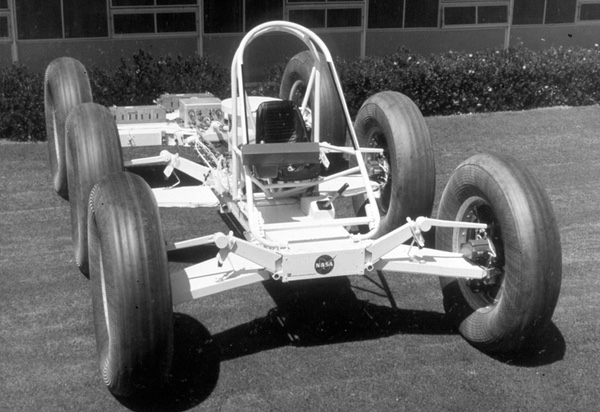 In the mid-1960s, General Motors built the MOLAB Test Article, or MTA, to demonstrate the driving abilities of their Mobile Laboratory design. The mass of the chassis and wheels on Earth was equivalent to the full vehicle, including pressurized modules, on the Moon. (credit: Norman J. James via GM Media Archive) |
According to James, they calculated that the MTA’s chassis and running gear would be able to successfully simulate operating in one-sixth gravity by itself, simply by leaving off the pressurized compartments that would sit on top. Whereas GM’s Surveyor rover had three separate chassis in a 6x6 configuration, for MOLAB they decided to go with a 4x4 forward platform and a 2x2 trailer because it allowed them to carry more payload at the cost of some mobility. In contrast, GM’s competitor Bendix had decided on a 4x4 vehicle.
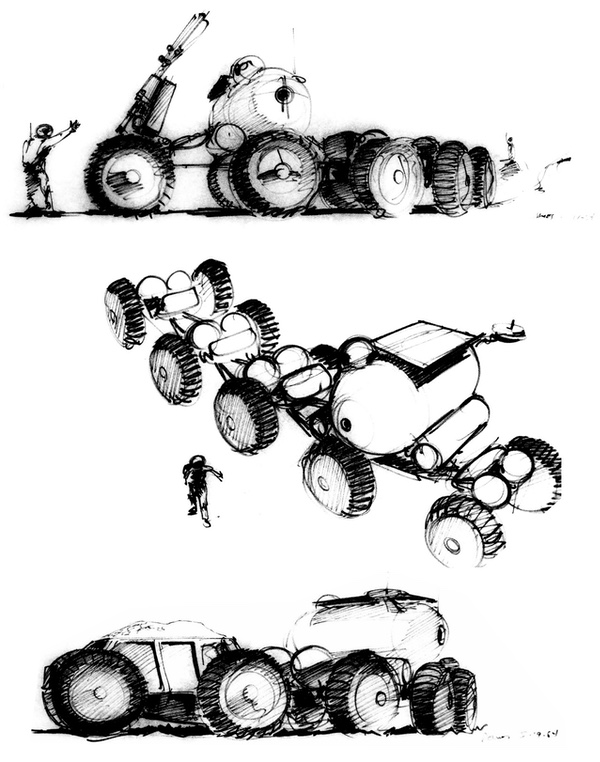 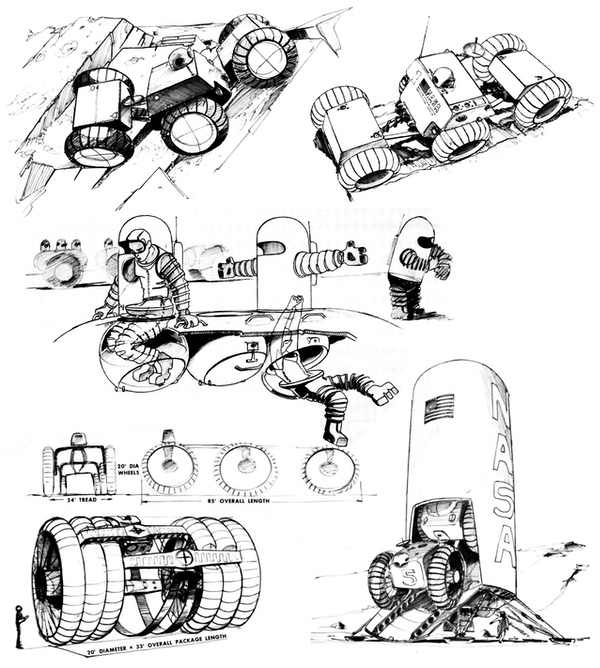 As the GM team began working on what eventually became the Mobile Laboratory, or MOLAB, they explored many possible design configurations before settling on a much more conventional approach. (credit: Norman J. James via GM Media Archive) |
MOLAB was not included in the existing Apollo program but was part of NASA’s mid-60s optimism about an expanded future human space exploration program. It would have been big and expensive and required substantial upgrades to Apollo hardware.
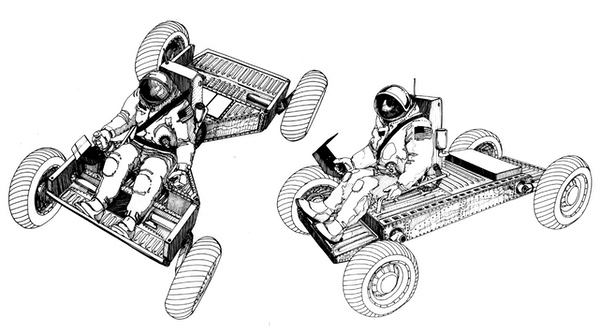 After working on large pressurized lunar rovers during the mid-1960s, GM's design team began exploring smaller one and two-seat rovers that could be carried on existing Apollo missions. (credit: Norman J. James via GM Media Archive) |
Scaling back, the Lunar Roving Vehicle
After submitting their MTA to NASA for evaluation, James said that the GM team gradually came to realize that they were looking too far into the future—after the initial Apollo missions—when they should instead focus more on supporting Apollo. They began looking at designing a smaller vehicle to carry one or two astronauts during a later Apollo mission.
As the GM team began developing proposals for a smaller rover, they had to consider how to accommodate the astronauts in their bulky lunar spacesuits. How big would the seats and driving area of a lunar vehicle have to be so the astronauts could operate it? GM was still assuming their 6x6 chassis approach was best, even though Bendix was considering a similar small vehicle with only four wheels.
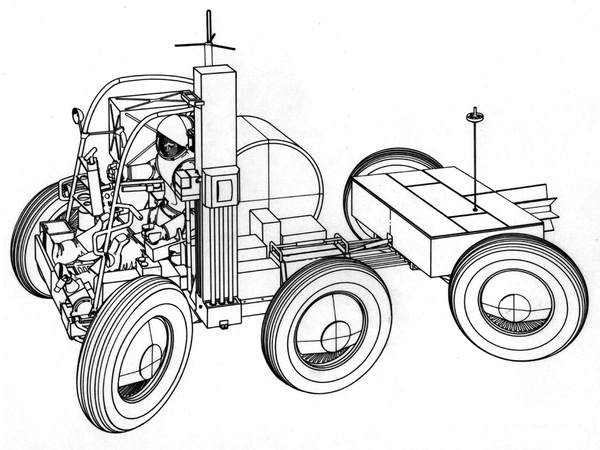 Early on, General Motors settled on a six-wheeled configuration for its Surveyor rover which it carried on through other lunar rover designs. This two-person concept was developed after GM had started moving beyond its large pressurized MOLAB work. (credit: Norman J. James via GM Media Archive) |
NASA issued a request for proposal for a Local Site Survey Module (LSSM), and GM’s team was prepared to respond. They submitted their proposal but did not get an award from NASA, which apparently put the project on hold. The GM team continued working on improving their wheel design, trying to increase its performance over soft ground and avoiding some of the potential problems that worried them. “The competition between GM and Bendix was simple,” James wrote. “GM was betting on the best performance to overcome unexpected circumstances on the Moon; Bendix was betting on expecting no problems and solving everything as simply as possible, at the lowest cost.”
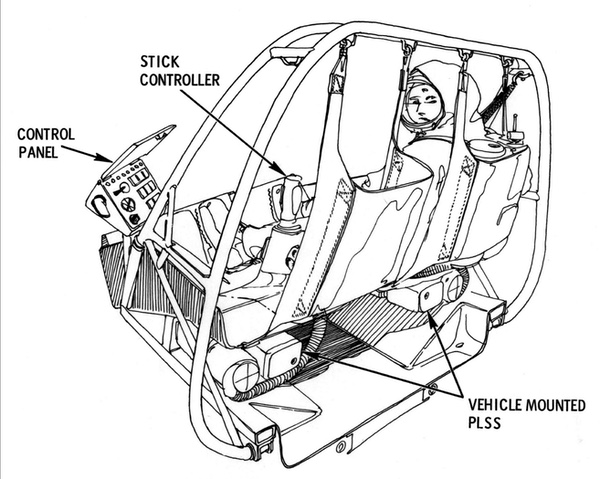 One aspect of designing small rovers for the lunar surface was determining how the space-suited astronauts would fit in and drive them. Norman James worked on designs that could hold the astronauts while bouncing over the lunar surface. (credit: Norman J. James via GM Media Archive) |
NASA issued yet another request for proposals to further resolve technical uncertainties. This time GM won the contract. The company built a test fixture to test the wheel designs of both GM and Bendix. The test fixture would fit inside a thermal vacuum chamber to simulate the wheel operating under lunar conditions, going over different obstacles.
James left GM to work for Lockheed Aircraft on their new L-1011 airliner before GM heard from NASA about which company would be awarded the contract. In October 1969, Boeing was awarded the Lunar Roving Vehicle contract, with GM as a subcontractor. The LRV used a 4x4 design rather than GM’s preferred 6x6 approach.
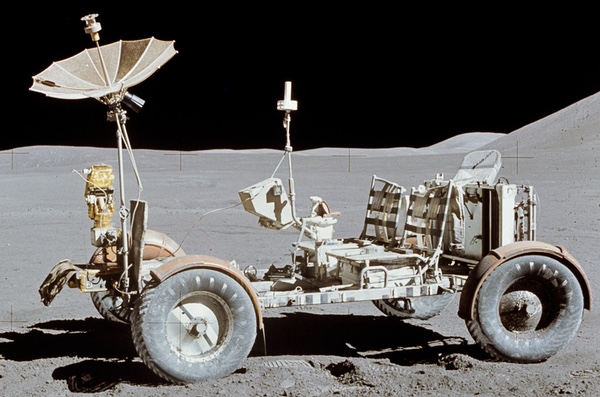 After working for many years on lunar roving vehicle concepts and prototypes, GM eventually teamed up with Boeing to develop the Lunar Roving Vehicle, which flew on Apollos 15-17 and extended the amount of territory the astronauts could cover on the Moon. (credit: NASA) |
The story of the development of the Lunar Roving Vehicle is explored in much greater detail in Earl Swift’s excellent 2021 book Across the Airless Wilds and the excellent documentary “Moon Machines.” The LRV was used on Apollos 15 through 17 and proved to be a valuable addition to the Apollo program, extending the range of science exploration beyond the short walking distance from the Lunar Module. General Motors, known for being a major force in the history of the automobile, made it possible for astronauts to drive around the Moon.
Note: we are now moderating comments. There will be a delay in posting comments and no guarantee that all submitted comments will be posted.
